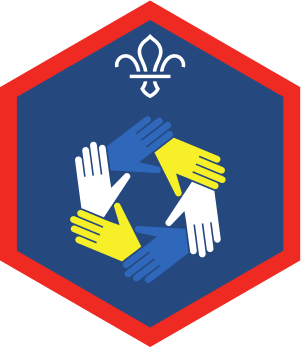Market stall challenge
You’ll need
- Coloured pens or pencils
- Big pieces of paper
- Scissors
- Sticky tack
- Permanent markers
- Access to the internet
Before you begin
- You may want to let everyone know about this activity before your meeting to give them time to research their ideas or collect any props.
- Decide whether you want everyone to choose from a list of options, or dream big and make up their own ideas.
- This activity is a great opportunity to use up any ‘scraps’ of craft materials.
Get ready to create
- The person leading the activity should set all of the craft materials out at the side of the meeting place.
- Everyone should split into groups.
- Each group should choose an activity, idea, or meeting that they’d like to do. They should work together to think about how they’ll sell this idea to everyone else – what makes it exciting, and why should everyone choose it?
- Everyone should visit the craft materials and take what they need to get started. They should remember to be fair and share the materials equally.
Create market stalls
- Everyone should use the craft materials to transform a table into a market stall ‘selling’ their idea. They should make posters and banners full of images, information, and slogans.
- As everyone’s creating, the people leading the activity should wonder around visiting each group. They should pretend to be ‘Quality Control Advisers’ whose role is to help everyone consider the practicalities so their ideas are realistic.
- Once everyone’s finished, the space should be full of exciting displays.
Visit the market
- Everyone should take it in turns to visit all of the stalls. It may be a good idea to do this in groups, so there’s always someone at the stall to explain ideas and answer questions.
- Everyone should decide which activity they like the most. It might be their favourite because it’s helpful for a badge they want to achieve, or it might just look really fun.
- Everyone should vote for their favourite activity. The person leading the activity should remind everyone that it doesn’t matter whose activity gets the most votes – it’s more important that people choose the activity they most want to do.
- The people who plan the programme should count up all of the votes and make a note of the results. They should use these results when they plan the programme in the future.
Reflection
This activity needed everyone to work as a team. Was it easy to come up with one idea for the stall? Did everyone do the same thing when they were creating the stall, or did they split the work between everyone? People can learn lots from this activity. When might they use what they learned? People could think about other times they work in teams, for example, playing sports, at school, or even in the future at work.
This activity was also about developing skills. Planning in a skill in itself, but making a plan uses lots of other skills as well, for example, being creative, researching, and budgeting. Can anyone think of other skills they used? When else might they use these skills in the future?
Safety
All activities must be safely managed. You must complete a thorough risk assessment and take appropriate steps to reduce risk. Use the safety checklist to help you plan and risk assess your activity. Always get approval for the activity, and have suitable supervision and an InTouch process.
- Scissors
Supervise young people appropriately when they’re using scissors. Store all sharp objects securely, out of the reach of young people.
- Online safety
Supervise young people when they’re online and give them advice about staying safe. Take a look at our online safety or bullying guidance. The NSPCC offers more advice and guidance, too. If you want to know more about specific social networks and games, Childnet has information and safety tips for apps. You can also report anything that’s worried you online to the Child Exploitation and Online Protection Command. As always, if you’ve got concerns about a young person’s welfare, including their online experiences, follow the Yellow Card to make a report.
It’s up to you whether you give people a choice from a list of options or allow them to come up with their own ideas. It’s also up to you how much information and guidance you give (for example, information sheets and resources) and how helpful the Quality Control Advisors are.
It’s OK for different people to take different roles. Spelling doesn’t matter too much, but if some people are more comfortable not writing, that’s OK. Not everyone needs to present, either.
All Scout activities should be inclusive and accessible.
This is also a great way for Explorers working towards their Chief Scout’s or Queen’s Scout Award to suggest activities they’d like to run for the group as part of their ICV section.
Youth shaped Scouts should be embedded as part of your balanced programme. Scouts should be involved in making decisions and choosing activities to make sure their programme is what they want it to be.

